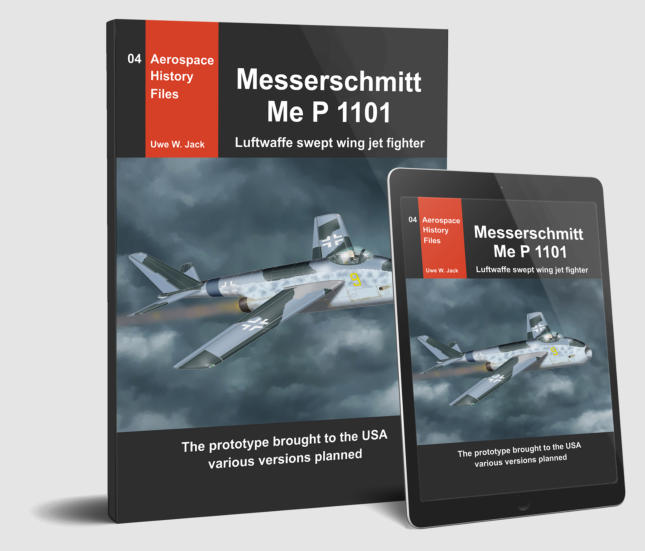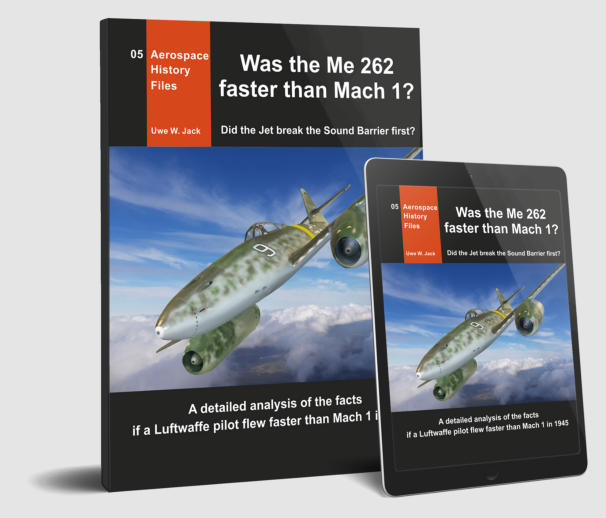
Junkers Ju 287
The most advanced jet bomber of the Luftwaffe
This is the story of an aircraft that might have changed the air-war in 1945/46.
Lots of photos, drawings, information, data and more than 9600 words give a
detailed insight into the development of this unique piece of aviation.
When US troops in May 1945 moved into the Junkers aviation works in
East Germany, they discovered two very unusual aircraft with forward-swept
wings. They marveled at the first two prototypes for the Luftwaffe’s new long-
range jet-bomber - and handed them over to the Russians.
The Junkers documents on swept wings found there, changed the aviation
industry of the USA, the United Kingdom, Russia, and other nations. Boeing
immediately modified the design of its B-47 and B-52 under development. The
Russians build further prototypes and learned much from this advanced aircraft.
Uwe W. Jack in 1990 discovered documents that proved that all other
publication to date on this aircraft had been wrong. He met the chief test pilot of
Junkers, who had flown the prototype of the Ju 287 and got first-hand
information on its behavior in the air. Uwe W. Jack shared his knowledge
liberally with other authors - but now publishes his version.
Don't miss the first part of the series - Aerospace History Files 01 !
More than 100 illustrations
44 pages
Large format: 21.6 x 27.9 cm (8.5” x 11”)
Aerospace History Publications for Experts
Find hundreds of Docs and Photos for free here!
JAP
Jack Aerospace Publishing
Print or Kindle-eBook:
eBooks:
epub mobi pdf lrf pdb txt html:



Reichenberg
The piloted V-1 missile
To date there have been numerous misinterpretations about the back-
ground of the Luftwaffe suicide operation, the motivation of the pilots and
the technology of the „Reichenberg" flying bomb.
You will find many photographs and drawings of the different versions
of the „Reichenberg" trainer and operational aircraft. A restoration in
Germany of three surviving suicide aircraft offered the chance to provide
this publication with many detailed photographs.
The author had the unique chance to speak to three former Luftwaffe
pilots who volunteered for a suicide mission.
Don't miss this new publication of the series - Aerospace History Files 02 !
More than 100 illustrations
63 pages
Large format: 21.6 x 27.9 cm (8.5” x 11”)
Print or Kindle-eBook:




Aerospace History Documents - for Aviation Historians and Engineers
For aviation historians who would like to delve deeper into the subject, there are reprints of important,
rare (mostly top secret) documents in the "Aerospace History Documents" series.
These publications complement the publications of the “Aerospace History Files” series.
Roll- und Schiebemessungen am
Modell Ju 287
A reprint of a secret report from the German
Research Institute for Aviation (DVL) at Berlin-
Adlershof from February 1945 to the
Reichsluftfahrtministerium (RLM). The report
examines the spinning behavior of a 1:11 scale
model of the Junkers Ju 287 with forward swept
wings in the institute's wind-tunnel. The stall
behavior was also examined with the flow directly
from the front and at small sideward angles.
This unique piece of aviation history comes with
52 pages, diagrams, drawings, and wind-tunnel
photographs from the model examined at the
DVL.
English summery - document-text in German.
Messungen am Modell Ju 287
This publication is a reprint of a secret report
from the Junkers company from August 1944 to
the Reichsluftfahrtministerium (RLM). After the
design of the Junkers Ju 287 changed from two
engines at the fuselage sides plus twin nacelles
under each wing to a triple engine cluster under
the wings, the Junkers design office needs a
forecast of the aircraft's flight characteristics. A
large model of 1:4.5 scale was examined in the
company's wind-tunnel at Dessau.
This reprint comes with 50 pages with
drawings of the wind-tunnel model and lots of
diagrams and drawings of air flow analysis.
English summery - document-text in German.
Überblick über Auslegung und
Entwicklung des Strahlbombers Ju 287
Reprint of a secret report from the Junkers
company from September 1944 to the Reichs-
luftfahrtministerium (RLM). Junkers reports
technical and military data for the future planning
of the Luftwaffe's bomber force. Six prototypes
and additional test aircraft for components of the
Ju 287 under development are described. A pre-
series of 154 aircraft was planned, followed by
the A-series with BMW 003 engines and the B-
series with Jumo 004 C engines.
24 page reprint pages with tables, diagrams
and three model photographs of how the Ju 287
would have looked in Luftwaffe camouflage.
English summery - document-text in German.



Messerschmitt Bf 108 Taifun
The Messerschmitt Bf 108 Taifun is still one of the
most elegant aircraft ever built. Reprint of a
company brochure showing various possible uses
of the aircraft.
An introduction to the aircraft by the author. All
text passages are translated literally.
With many drawings of technical features of the
Messerschmitt Taifun.
41 pages
Document-text in German.
Reichenberg
Luftwaffe manned suicide missile
A collection of very rare, secret documents on
the history of the idea of self-sacrifice airplanes
and operations in the Luftwaffe.
The core passages are explained and some
are translated literally. An introduction explains
the circumstances in which the documents were
created.
This reprint comes with 71 pages with some
drawings and pictures.
English summery - document-text in German.
Aggregat A4 - Vergeltungswaffe V-2
The V-2 rocket was used in large numbers
against enemy cities. The necessary experience
in the operation of such a complex system was
to be provided by the first A series.
A technical description was drawn up for the
soldiers who were to launch these missiles and
learn in the process, which is hereby published
for the first time as a reprint.
A short introduction informs the reader about
the background of the development and the
specific characteristcs of the Aggregat A4 rocket.
Important text passages of the A-series
handbook are translated. Detailed drawings and
photographs show interesting details of the V-2
rocket. It is a real collectors piece.
117 pages - Document-text in German.




Print or Kindle-eBook:


Messerschmitt
Me 263 / Ju 248
The ultimate rocket fighter
In the 1930s in Germany, rocket engines and air-breathing jet engines were
considered equal means of propulsion for high-speed aircraft. The
Messerschmitt Me 163 was a rocket-powered interceptor that could climb
vertically at a fantastic rate. The Messerschmitt company and Alexander
Lippisch then developed the improved successor, the Me 263 (also named
Junkers Ju 248). This fighter had everything that could be expected for
successful use in the Luftwaffe. Its top speed was 1000 km/h.
By the end of the Second World War prototypes of the Me 263 had
flown and additional aircraft were under construction. The Soviet Union was
impressed and rebuilt and tested this rocket-aircraft as the I-270. A version
flew in Great Britain as the De Havilland D.H. 108 with an air-breathing
turbine engine.
Many photos, original drawings and descriptions present this
extremely unusual fighter aircraft in great detail. A publication that should
not be missed by anyone interested in the Luftwaffe or aviation technology!
More than 80 illustrations
42 pages
Large format: 21.6 x 27.9 cm (8.5” x 11”)


Print or Kindle-eBook:

Messerschmitt
Me P 1101
Luftwaffe swept wing jet fighter
In the summer of 1944, the Luftwaffe called for a single-seat fighter aircraft
with a jet engine. This aircraft was to regain air supremacy over Germany
through superior flight performance. The Messerschmitt company then
developed the P 1101 project with an outstanding design. Versions were
planned as day fighters, all-weather fighters, night fighters and
reconnaissance aircraft. The aircraft was to have swept wings to enable it to
fly fast. As Messerschmitt was not sure what the best sweep angle would be,
a test aircraft was built in which the wings could be adjusted on the ground in
order to find the optimum design. This aircraft was almost completed when
American troops reached the Messerschmitt factory. The Bell company
brought the P 1101 to the USA and built its own version as the X-5.
Many photos, original drawings and descriptions present this extremely
unusual fighter aircraft in great detail. A publication that should not be missed
by anyone interested in the Luftwaffe or aviation technology!
More than 80 illustrations
50 pages
Large format: 21.6 x 27.9 cm (8.5” x 11”)

Print or Kindle-eBook:

Was the Me 262
faster than Mach 1?
Did the Luftwaffe Jet break the Sound Barrier first?
It seems to be a fact that the first pilot to fly faster than the speed of sound
was the American Chuck Yeager with the Bell X-1 in 1947.
However, there are repeated claims that a Luftwaffe pilot broke the sound
barrier as early as 1945 with a Messerschmitt Me 262 jet fighter.
The author Uwe W. Jack spoke to this pilot and had him describe his flight.
He also interviewed competent contemporary witnesses, such as the well-
known engineer Ludwig Bölkow, who worked on the design of the wings of
the Me 262, and former Luftwaffe test pilots and combat pilots.
In this publication the arguments for the world‘s first supersonic flight by a
Luftwaffe pilot and the objections against it are analyzed in detail. An
important and exciting chapter in aviation history can thus finally be brought
out of the realm of speculation.
Many photos illustrate this search for the truth. An important source for
aviation historians.
More than 100 illustrations
58 pages
Large format: 21.6 x 27.9 cm (8.5” x 11”)











